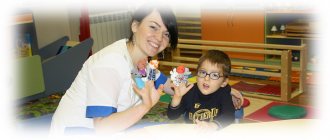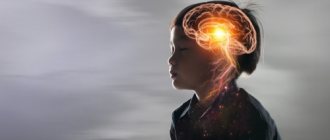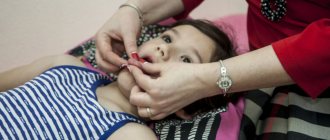2.6.4. Differential diagnosis of dysarthria from similar speech disorders
Distinctive signs of erased forms of dysarthria from dyslalia
A broad analysis of practice has shown that erased forms of pseudobulbar dysarthria are quite often confused with dyslalia (Table 2.14). However, correcting sound pronunciation with dysarthria causes certain difficulties. G. Gutsman was the first to draw attention to this. He noted that these disorders are characterized by blurred, erased articulation. Having summarized the analysis of literary data, M.B. Eidinova and E.N. Pravdina-Vinarskaya explain disorders of the articulatory apparatus by its insufficient innervation and consider these cases as dysarthric. Despite the fact that in both dysarthria and complex dyslalia, hissing, whistling and sonorant groups of sounds are more likely to suffer, for dysarthria, correct isolated pronunciation of sounds is possible, but in spontaneous speech there is blurriness, palatalization, nasalization, and a violation of the prosodic side of speech. Children often say the end of a phrase while inhaling, the voice is hoarse, weak, quiet, and fading.
| Dislalia | Dysarthria |
| 1. In somatically weakened children. There is no organic matter. | 1. Associated with damage to the central nervous system (c.n.s.) |
| 2. There are no neurological symptoms. | 2. Asymmetry of the face, tongue, and soft palate is clearly expressed; the mouth at rest is slightly open due to paresis of the lips, the smoothness of the nasolabial folds is different. |
| 3. The motor sphere is without pathology, tendon reflexes are lively and uniform. | 3. General, fine and articulatory motor skills suffer. |
| 4. Only sound pronunciation suffers. The prognosis is favorable. | 4 Along with sound pronunciation, prosody suffers. The supplied sounds are difficult to automate. |
| 5. The voice is ringing, loud, richly modulated. | 5. The voice is dull, weak, compressed, fading, intermittent. |
| 6. Speech activity is increased | 6. Speech activity is reduced. |
| 7. He is critical of his defect. | 7. “He sees a speck in someone else’s eye, but he doesn’t notice a log in his own.” |
| 8. Autonomic disorders manifest themselves in sweating of the extremities and red dermographism of the skin. | 8. Autonomic disorders are grossly expressed: bluish, cold, wet extremities. |
| 9. Hygienic skills are developed quickly and maintained firmly. Outwardly, children are neat. | 9. Hygienic skills are difficult to develop due to motor impairments. Untidy. |
| 10. Restful sleep without night fears and dreams. | 10. Sleep disorders, night terrors, and dreams are observed. |
| 11. Diaphragmatic-speech breathing is normal. | 11. Breathing is shallow, clavicular, diaphragmatic-speech, unformed |
| 12. The child makes contact easily. His behavior is appropriate. | 12. Behavior is uneven, mood swings are frequent. |
| 13. Memory, attention, performance, thought processes, intelligence are normal, mental retardation (MDH) is rarely observed. | 13. Memory is reduced, short-term. Unstable attention, low performance. Intellect is reduced, often mental retardation (MDD), mental retardation to the degree of debility is possible. |
| 14. Children are active, mobile, engage willingly, and switch from one type of activity to another without much difficulty. | 14. They are slow or disinhibited, avoid activities, complain of headaches, have difficulty switching from one type of work to another. |
Main indicators for diagnosing dysarthria
Diagnosis of dysarthria is made based on the following indicators:
- Facial expressions. When the form is erased, it is expressive, without breaking symmetry, completely controlled, manageable. With a moderately severe disease, expressiveness is weak, asymmetry is obvious. The position of the lips is not fully controlled, which is why the mouth remains slightly open even in a calm state. In severe forms, facial expressions are weak, strong asymmetry is observed, the mouth is always open, and the tongue cannot be held in it.
- Breath. The erased form is characterized by mixed abdominal breathing, uniform functioning of both halves. In the second degree, breathing is clavicular, superficial, and arrhythmia is periodically recorded. The severe form is associated with weak and shallow breathing, arrhythmia, and extremely weakened exhalation.
- Voice formation. In the third degree, the voice is soft, the stream of air emanating during exhalation and speaking is not reduced in volume, but differs in length. In the second degree, the voice is harsh, and the voice itself has signs of attenuation, and paresis of the vocal cords is observed. The first degree is associated with a weak, intermittent voice, so attenuated that sometimes it completely disappears, sometimes the ability to speak exclusively in a whisper remains, the vocal cords close unevenly.
- Reflex motor activity of the tongue. In the erased form, it is completely preserved, no problems with chewing or licking lips arise. At the second stage, volume and tempo are limited, and it is clear that speech functions are depleted. In severe cases, the tongue is unable to move fully and at the desired pace.
- Position, shape of the tongue. At the first stage, the organ has a clear shape, divided into two equal halves by the midline, the tip is well defined. With a disease in the middle stage, the tongue becomes wider, begins to deviate in the direction that remains in a healthy state, and there is no clearly formed tip. The severe form is characterized by obvious asymmetry, and unilateral atrophy is present.
- Maintaining articulatory posture. In the third degree, there are no difficulties with holding for a long time, there is no cyanosis, and increased salivation is possible. At the second stage of the disease, the pose can be held for 10 seconds, but trembling, blueness, and profuse salivation are observed. In severe cases, problems arise with maintaining a posture even for a 5-second period of time; there is either severe trembling or an inability to hold the tongue in the oral cavity.
- Voluntary motor activity of the tongue. With an erased form, the volume and tempo of movements are not limited in any way, only differentiated articulation may be slightly impaired. The second degree is associated with a slight asymmetry and slower tempo of movements, difficulty transitioning from one articulatory movement to another, and exhaustion of speech functions. It is difficult for seriously ill patients to change articulation, their speech loses coherence, and their tongue is consistently asymmetrical.
- Soft sky. At the initial stage, it is located in the midline, capable of actively contracting when there are prerequisites for this. With moderate severity, its asymmetry is observed, as a result of which slight nasality develops. The first degree is characterized by partial paresis and significant nasality.
- Voluntary movements of the lips. When the form is erased, the symmetry of movements is fixed, volume and tempo are preserved, movements with resistance are performed well. In the second degree, the smile or the pipe loses symmetry, the pace slows down, and movements with resistance become more difficult. The severe form is characterized by a clear asymmetry, an extremely slow pace and incomplete amplitude, and the inability to use resistance.
- Hyperkinesis. At the initial stage they are absent, at the second stage they arise, but from time to time, when a severe form is reached, they are observed constantly.
- Oral synkinesis. With the erased form they are not observed, with the disease of the second degree they are weakly expressed and appear only occasionally, with the first degree they are continuous and intensify when speaking.
- Pronunciation. In the third degree, isolated sounds are clear, but blurring may occur if speech is spontaneous. Patients with the second degree may have correct pronunciation, but it is not intelligible enough, especially in certain sound groups. In severe forms, distortions are almost always recorded, nasality appears, and the voice becomes inexpressive.
Differential diagnosis of forms of dysarthria
Dysarthria has the following forms:
- bulbar;
- pseudobulbar;
- cortical;
- subcortical;
- cerebellar
Bulbar occurs due to the fact that the medulla oblongata is affected.
It can be identified due to symptoms such as:
- destruction of the nuclei of the motor nerves of the cranial group;
- partial or complete immobilization of the muscles of the organs responsible for the formation of sounds;
- difficulties in performing swallowing and chewing functions;
- deterioration in vocal fold mobility; the appearance of defects when producing voiced sounds;
- weakening of the voice and the appearance of nasality;
- decreased tone or complete failure of the tongue muscles;
- lack of normal facial expressions.
Pseudobulbar develops in those individuals whose brain has organic damage. The key symptoms are paresis or paralysis of the vocal apparatus, difficulty performing sucking and swallowing movements, improper speech motor skills, inability to swallow saliva in full, choking while eating, and impaired facial expressions.
Cortical occurs when the brain is affected in a focal manner. It is expressed in a violation of the pronunciation of complex words, distortion of voluntary motor skills of articulatory organs, difficulty in transitioning between sounds, distortion of sounds during their streaming playback, acceleration of the tempo of speech with the simultaneous appearance of hesitations in it.
Subcortical is caused by damage to the subcortical nodes of the brain. It is expressed by the appearance of involuntary articulation and facial expressions; impaired muscle tone; involuntary screams; spasms of the articulatory apparatus; periodic “skipping” of sounds; changing the usual speech rate; violation of voice intonation, strength and timbre. In some cases it is combined with hearing impairment.
Cerebellar is a consequence of lesions localized in the cerebellum. The main symptoms are intermittent articulation, difficulty maintaining articulatory patterns, imprecise motor activity of the tongue, and impaired voice modulation.
Methods for diagnosing dysarthria
In most cases, dysarthria is mixed, that is, one patient has a combination of several clinical syndromes. In particular, a violation of the pronunciation of sounds is often accompanied by a deterioration in the clarity of speech, stuttering, acceleration or deceleration of speaking speed, underdevelopment of gross motor skills and other symptoms.
Their severity depends on how severe the organic brain damage is, as well as on the nature of this lesion.
The main stage of diagnosis is carried out by a speech therapist, who conducts an examination in several stages, assessing how correctly the patient breathes, how uniform the speech is, how he pronounces isolated sounds and complete phrases. Testing is also carried out to determine how developed written language is in a particular person.
Additional diagnostics is aimed at identifying those parts of the nervous system in which the lesion is localized. To do this, resort to the following methods:
- electrophysiological study (EEG and assessment of facial muscle activity);
- MRI of the brain;
- study of the cerebral hemispheres using the method of transcranial magnetic radiation.
Diagnosis of dysarthria requires a comprehensive approach that takes into account the characteristics of speech and non-speech disorders, the general condition of the patient from the point of view of psychoneurology, as well as the patient’s age.
Diagnosis based on local diagnostic features
The importance of correct diagnosis is due to the fact that different forms of the disease require the use of radically different correlation techniques.
Cortical dysarthria is often confused with dyslalia, but the latter is not characterized by the presence of symptoms of organic damage, producing sounds and bringing them to automation is easier and faster, and the likelihood of getting rid of the problem is high.
Experts can give a prognosis for patients suffering from cortical dysarthria only based on how accurately and timely the diagnosis is made, how severe the defect is, what methods of influence from the arsenal of speech therapists and doctors are chosen, and how long their use is planned.
In the subcortical form of the disease, muscular dystonia is observed; facial expressions and articulation are accompanied by violent movements, sometimes manifested even in a calm state. Characteristic are unstable and heterogeneous disturbances of speech, its speed, rhythm, and intonation.
In the bulbar form, peripheral paresis and paralysis are recorded, but they are characterized by lethargy and selectivity of appearance. Facial amymia is observed, the patient has difficulty chewing and absorbing food, both solid and liquid.
The voice is characterized by weakness, nasality, deafening of ringing sounds. There is slurring, unclearness and slowness of speech, and serious distortion of labial sounds.
The pseudobulbar form is associated with increased muscle tone of certain groups and limited movements of any category. There is tension in the tongue, its pulling back and deviation to the healthy side, and the inability to swallow saliva. Motor activity is slow, has a small amplitude, and is characterized by exhaustion. There are difficulties in pronouncing complex sounds of the front-lingual group; voiceless vowels are pronounced more loudly than required. Nasalization of sounds is recorded.
Dysarthria of the cerebellar form is indicated by a decrease in the tone of the labio-lingual muscles, a flattened and limitedly mobile tongue, and articulatory postures that are difficult to maintain. The articulatory organs are not able to move fully and at the usual pace.
Facial movements are sluggish, coordination of movements is impaired. Speech is characterized by slowness, inexpressiveness, chanting, and a fading effect towards the end of the phrase. The speech, as well as the gait, of such a patient are similar to those of drunk people.






